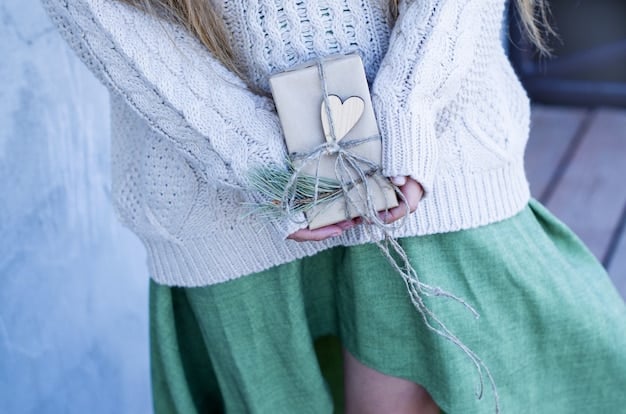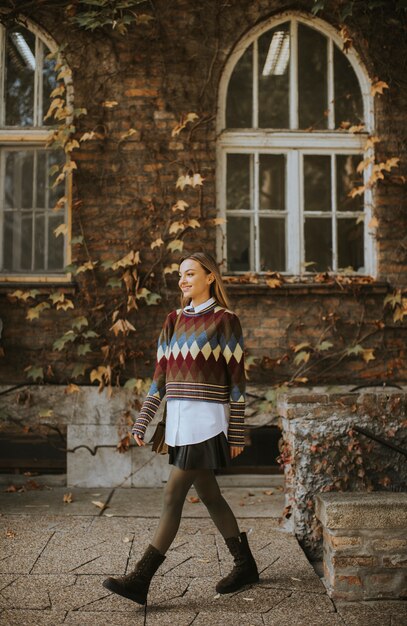Mastering the Art of Layering: Versatile Outfits for Any Season in the US

Advertisements
Mastering the art of layering is essential for creating versatile outfits that adapt to the unpredictable weather in the US, allowing you to seamlessly transition through spring, summer, fall, and winter with stylish and functional ensembles.
Are you tired of having a closet full of clothes but nothing to wear? Mastering the art of layering: create versatile outfits for any season in the US is the key to unlocking endless outfit possibilities and ensuring you’re always prepared for whatever the weather throws your way.
Advertisements
Understanding the Basics of Layering
Layering is more than just throwing on extra clothes when it’s cold. It’s an art form that, when mastered, allows you to create outfits that are both stylish and functional. Understanding the principles behind layering can transform your wardrobe and simplify your daily dressing routine.
The Importance of Fabric Choice
The foundation of any successful layered outfit lies in the fabrics you choose. Selecting the right materials ensures comfort, breathability, and temperature regulation, no matter the weather.
Advertisements
- Base Layers: Opt for moisture-wicking fabrics like merino wool or synthetic materials. These keep you dry and comfortable by drawing sweat away from your skin.
- Mid Layers: Choose insulating materials such as fleece or down. These trap heat and provide warmth without adding bulk.
- Outer Layers: Select water-resistant and windproof fabrics like Gore-Tex or nylon. These protect you from the elements and keep you dry and comfortable in wet conditions.
The Role of Fit in Layering
The fit of your clothing is just as important as the fabric. Properly fitting layers allow for ease of movement and prevent you from feeling restricted or bulky.
- Base Layers: Should fit close to the body without being too tight. This allows them to effectively wick away moisture and provide a comfortable foundation.
- Mid Layers: Should fit comfortably over your base layer, allowing room for movement without being too loose.
- Outer Layers: Should be roomy enough to accommodate your base and mid layers without feeling restrictive.
Choosing the right fabrics and ensuring a proper fit are essential for creating comfortable and versatile layered outfits. By paying attention to these details, you can create looks that are both stylish and functional, no matter the season.
Layering for Spring in the US
Spring in the US is a season of transition, with unpredictable weather patterns that can range from warm sunny days to cool, rainy afternoons. Layering is key to navigating these fluctuations and staying comfortable throughout the day.

Light Jackets and Cardigans
Light jackets and cardigans are essential for spring layering. They provide an extra layer of warmth when needed and can easily be removed or tied around your waist when the temperature rises.
- Denim Jackets: A classic choice that pairs well with almost anything.
- Cardigans: Versatile and comfortable, perfect for adding a touch of warmth without bulk.
- Trench Coats: A stylish option for rainy days, providing protection from the elements while still looking chic.
Versatile Tops and Bottoms
Choosing versatile tops and bottoms allows you to create a variety of outfits with minimal effort. Neutral colors and simple designs are easy to mix and match.
- Long-Sleeved Shirts: Lightweight and breathable, perfect for layering under jackets or sweaters.
- T-Shirts: A basic staple that can be dressed up or down.
- Jeans: A versatile option that can be paired with almost any top or jacket.
Spring layering in the US requires adaptability and versatility. By incorporating light jackets, cardigans, and versatile tops and bottoms into your wardrobe, you can create stylish and comfortable outfits that are perfect for any spring day.
Summer Layering Strategies
Summer in the US often brings to mind images of scorching heat, but layering can still be a valuable strategy, especially for evenings or indoor environments with strong air conditioning. The key is to focus on lightweight, breathable fabrics and strategic layering techniques.
Lightweight Outerwear Options
Even in the summer, having a few lightweight outerwear options can be useful for cooler evenings or when you want to add a touch of style to your outfit.
- Lightweight Cardigans: Choose thin, breathable fabrics like cotton or linen for added comfort.
- Kimono: A stylish and breezy option that can instantly elevate any outfit.
- Oversized Shirt: Wear it unbuttoned as a light jacket or tie it around your waist for a casual look.
Strategic Use of Accessories
Accessories can play a crucial role in summer layering, adding both style and practicality to your outfit.
- Scarves: Opt for lightweight scarves in breathable fabrics like silk or linen.
- Hats: A stylish way to protect yourself from the sun and add a touch of personality to your look.
- Sunglasses: Essential for protecting your eyes from the sun and adding a touch of glamour to your outfit.
Summer layering is all about adding subtle layers that provide comfort and style without causing overheating. By focusing on lightweight outerwear and strategic accessories, you can create versatile summer outfits that are perfect for any occasion.
Fall Layering for Style and Warmth
Fall in the US is a season of vibrant colors and cooler temperatures, making it the perfect time to experiment with different layering combinations. The goal is to stay warm and comfortable while showcasing your personal style.
Key Pieces for Fall Layering
To build a successful fall wardrobe, it’s essential to have a few key pieces that can be mixed and matched to create a variety of outfits.

- Flannel Shirts: A classic fall staple that can be worn alone or layered under jackets and sweaters.
- Sweater Vests: Add a touch of warmth and style without adding bulk.
- Wool Coats: A timeless option that provides warmth and sophistication.
Combining Textures and Colors
Fall is the perfect time to play with different textures and colors to create visually interesting outfits.
- Texture: Mix and match different textures like knitwear, leather, and denim for added depth and dimension.
- Color: Embrace the rich, warm hues of fall, such as burgundy, olive green, and mustard yellow.
- Prints: Add a touch of personality with patterns like plaid, stripes, or floral prints.
Fall layering is all about creating warm, stylish outfits that reflect the beauty of the season. By incorporating key pieces like flannel shirts, sweater vests, and wool coats, and by experimenting with different textures and colors, you can create a wardrobe that is both functional and fashionable.
Winter Layering Techniques
Winter in the US demands strategic layering to combat freezing temperatures and harsh weather conditions. The focus is on trapping heat and protecting yourself from the elements.
Essential Winter Layers
A well-planned system of layers is essential for staying warm and comfortable during the winter months.
- Base Layers: Thermals made of merino wool or synthetic fabrics provide a warm and moisture-wicking foundation.
- Mid Layers: Fleece jackets, down vests, or wool sweaters offer insulation and trap heat.
- Outer Layers: Insulated parkas, waterproof jackets, and sturdy coats provide protection from wind, snow, and rain.
Accessorizing for Warmth
Don’t underestimate the power of accessories when it comes to winter layering. They can make a significant difference in your overall comfort and warmth.
- Hats: Insulated hats made of wool or fleece keep your head warm and prevent heat loss.
- Scarves: Wrap a scarf around your neck and face for added protection from the cold.
- Gloves: Insulated gloves or mittens keep your hands warm and dry.
Winter layering is all about maximizing warmth and protection without sacrificing style. By investing in essential layers and accessorizing strategically, you can stay comfortable and fashionable throughout the coldest months of the year.
Creating Versatile Outfits
The ultimate goal of mastering the art of layering is to create versatile outfits that can be adapted to any situation or weather condition. This involves careful planning and a thoughtful approach to wardrobe selection.
Building a Capsule Wardrobe
A capsule wardrobe is a collection of essential pieces that can be mixed and matched to create a variety of outfits. This simplifies your wardrobe and makes layering easier.
- Neutral Colors: Stick to a neutral color palette of black, white, gray, and navy for easy mixing and matching.
- Classic Designs: Opt for classic designs that will stand the test of time.
- High-Quality Fabrics: Invest in high-quality fabrics that will last for years.
Mixing and Matching for Different Occasions
Once you have a solid foundation, you can start experimenting with different layering combinations to create outfits for various occasions. Here are a few examples:
- Casual Outfit: Jeans, a t-shirt, a cardigan, and sneakers.
- Business Casual Outfit: Dress pants, a button-down shirt, a blazer, and loafers.
- Evening Outfit: A dress, a shawl, heels, and statement jewelry.
Creating versatile outfits is the key to maximizing your wardrobe and simplifying your daily dressing routine. By building a capsule wardrobe and experimenting with different layering combinations, you can create a wardrobe that is both functional and stylish.
| Key Aspect | Brief Description |
|---|---|
| 👕 Fabric Choice | Select moisture-wicking, insulating, and weather-resistant fabrics. |
| 🧥 Layer Fit | Ensure each layer fits comfortably without being too tight or loose. |
| 🧣 Accessorizing | Use scarves, hats, and gloves for added warmth and style. |
| ⭐ Capsule Wardrobe | Build a wardrobe with essential, mix-and-match pieces. |
Frequently Asked Questions
▼
Merino wool or synthetic fabrics are excellent choices for base layers. They both offer moisture-wicking properties, keeping you dry and comfortable by drawing sweat away from your skin.
▼
Choose thinner, more lightweight layers. Opt for fitted pieces rather than oversized ones, and avoid layering too many bulky items on top of each other. Proper fit is key to a streamlined look.
▼
Yes! Focus on lightweight, breathable fabrics such as cotton, linen, or silk. A light cardigan or kimono can provide just enough coverage for air-conditioned environments or cooler evenings.
▼
Flannel shirts, sweater vests, and wool coats are excellent staples. These pieces can be easily mixed and matched, providing warmth and style during the cooler fall months in most parts of the US.
▼
Accessories are crucial for winter layering. Insulated hats, scarves, and gloves are essential for retaining heat and providing extra protection from the cold, wind, and snow, ensuring you stay warm and comfortable.
Conclusion
Mastering the art of layering is a valuable skill for anyone living in or visiting the US, where the weather can be unpredictable and vary greatly across different seasons. By understanding the principles of layering, choosing the right fabrics, and experimenting with different combinations, you can create versatile outfits that are both stylish and functional, no matter the temperature or weather conditions.